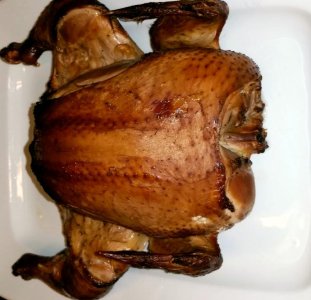Mr.Ed
New member
4 chickens in the 3D, a gastronomic feast to say the least.
I have been using this brine since I was knee high to a toadstool.
You have to study Nitrates and Phosphates to understand the benefits they impart to food, not only as a safety measure but also the huge benefit in moisture retention. My culinary training taught me the safe amounts of these brine ingredients to use. (*please do not exceed the recommended amounts I show in the brine recipe below.)
One gallon of brine for 4 chickens.
One gallon of water
1 cup of kosher salt
1/2 cup of raw sugar
2 TBS Old Bay
1 TBS potassium nitrate*
1 TBS sodium tripolyphosphate food grade*
Shake well until dissolved.
Take 4 one gallon Ziplocs and place a chicken in each bag. Add 1/4 gallon of the brine in each bag. Zip the bag 90% closed and squeeze until the brine starts coming out the top then seal. Do a 6 to 12 hour brine (I like 12 hours)
Smoke with apple, orange, or other light woods. I used 2oz. of orange, and 1oz. of sugar maple.
Pit 250 F. and I pull at 160 F. I know the book says 169 F but this brine will take care of any bad guys at 160 F
I do slit the skin between the thigh and the breast so the heat will be more evenly disbursed.
The end result surprised me. As you know I am new to the Si smoker family. It turned out every bit as good if not BETTER than my Superior smoker.
Boys and Girls you won me over to the art of Lazy Q.
I have been using this brine since I was knee high to a toadstool.
You have to study Nitrates and Phosphates to understand the benefits they impart to food, not only as a safety measure but also the huge benefit in moisture retention. My culinary training taught me the safe amounts of these brine ingredients to use. (*please do not exceed the recommended amounts I show in the brine recipe below.)
One gallon of brine for 4 chickens.
One gallon of water
1 cup of kosher salt
1/2 cup of raw sugar
2 TBS Old Bay
1 TBS potassium nitrate*
1 TBS sodium tripolyphosphate food grade*
Shake well until dissolved.
Take 4 one gallon Ziplocs and place a chicken in each bag. Add 1/4 gallon of the brine in each bag. Zip the bag 90% closed and squeeze until the brine starts coming out the top then seal. Do a 6 to 12 hour brine (I like 12 hours)
Smoke with apple, orange, or other light woods. I used 2oz. of orange, and 1oz. of sugar maple.
Pit 250 F. and I pull at 160 F. I know the book says 169 F but this brine will take care of any bad guys at 160 F
I do slit the skin between the thigh and the breast so the heat will be more evenly disbursed.
The end result surprised me. As you know I am new to the Si smoker family. It turned out every bit as good if not BETTER than my Superior smoker.
Boys and Girls you won me over to the art of Lazy Q.


 Sounds like you know your way around an equilibrium brine...
Sounds like you know your way around an equilibrium brine... 